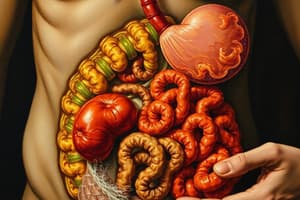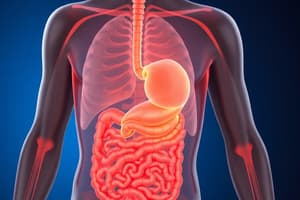Podcast
Questions and Answers
What is the main difference between mechanical and chemical digestion?
What is the main difference between mechanical and chemical digestion?
Mechanical digestion involves physical breakdown of food, while chemical digestion involves the breakdown of food using enzymes.
What is the function of the circulatory system in the digestive process?
What is the function of the circulatory system in the digestive process?
The circulatory system transports digested nutrients from the digestive system to the cells.
What is an example of a simple animal with a digestive sac?
What is an example of a simple animal with a digestive sac?
A jellyfish is an example of a simple animal with a digestive sac.
What are the four main steps of the digestive process?
What are the four main steps of the digestive process?
What type of digestion occurs in the mouth, stomach, and small intestine?
What type of digestion occurs in the mouth, stomach, and small intestine?
What is a characteristic of a complete digestive system?
What is a characteristic of a complete digestive system?
What is the primary function of amylase in the digestion process?
What is the primary function of amylase in the digestion process?
What is the purpose of mucus in saliva?
What is the purpose of mucus in saliva?
What is the term for the process of taking food in and swallowing it?
What is the term for the process of taking food in and swallowing it?
What type of muscle contractions occur in the esophagus to propel food towards the stomach?
What type of muscle contractions occur in the esophagus to propel food towards the stomach?
What is the main function of the stomach in the digestion process?
What is the main function of the stomach in the digestion process?
What is the maximum capacity of the stomach in terms of volume?
What is the maximum capacity of the stomach in terms of volume?
What is the average length of the gastrointestinal tract in humans, and what factors can influence its length?
What is the average length of the gastrointestinal tract in humans, and what factors can influence its length?
What are the two main types of digestion that occur in the mouth, and what are their roles in breaking down food?
What are the two main types of digestion that occur in the mouth, and what are their roles in breaking down food?
What is the role of the accessory organs in the digestion process, and what are some examples of these organs?
What is the role of the accessory organs in the digestion process, and what are some examples of these organs?
What is the primary function of the enzyme amylase in saliva, and how does it contribute to chemical digestion?
What is the primary function of the enzyme amylase in saliva, and how does it contribute to chemical digestion?
What is the relationship between the type of teeth an animal has and its diet, and how do herbivores and carnivores differ in this regard?
What is the relationship between the type of teeth an animal has and its diet, and how do herbivores and carnivores differ in this regard?
What are the six main stops in the journey of digestion, and what is the primary function of each stop?
What are the six main stops in the journey of digestion, and what is the primary function of each stop?
Flashcards
Mechanical vs. Chemical Digestion
Mechanical vs. Chemical Digestion
Physical breakdown of food vs. enzyme breakdown.
Circulatory System's Role
Circulatory System's Role
It transports digested nutrients to cells.
Animal with a Digestive Sac
Animal with a Digestive Sac
An animal with a simple pouch for digestion.
Four Main Steps of Digestion
Four Main Steps of Digestion
Signup and view all the flashcards
Complete Digestive System
Complete Digestive System
Signup and view all the flashcards
Amylase's Function
Amylase's Function
Signup and view all the flashcards
Purpose of Mucus in Saliva
Purpose of Mucus in Saliva
Signup and view all the flashcards
Ingestion
Ingestion
Signup and view all the flashcards
Peristalsis
Peristalsis
Signup and view all the flashcards
Main Function of the Stomach
Main Function of the Stomach
Signup and view all the flashcards
Digestion in the Mouth
Digestion in the Mouth
Signup and view all the flashcards
Accessory Digestive Organs
Accessory Digestive Organs
Signup and view all the flashcards
Teeth and Diet
Teeth and Diet
Signup and view all the flashcards
Stops in Digestion
Stops in Digestion
Signup and view all the flashcards




